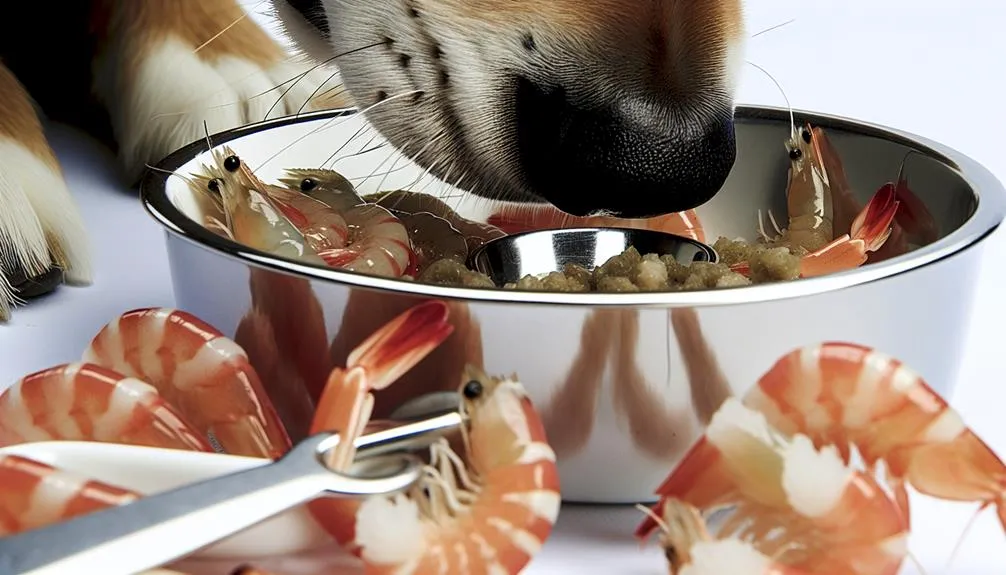
Is Shrimp Bad for Dogs
You might think giving your dog shrimp is like handing them a golden ticket to culinary heaven, but the reality is a bit more complicated. While shrimp can offer some nutritional benefits, there are significant risks you need to evaluate. From potential allergies to harmful bacteria lurking in raw shrimp, it's important to weigh both sides before making a decision. So, is shrimp truly a safe indulgence for your furry friend, or should it be avoided altogether? Let's explore the important factors that could impact your dog's health.
Nutritional Benefits of Shrimp
Including shrimp in your dog's diet can offer several nutritional benefits, but it's important to proceed with caution. Shrimp is a source of high-quality protein, which is fundamental for your dog's growth, maintenance, and overall health. The shrimp protein contains all nine indispensable amino acids, making it a complete protein source that supports muscle development and repair.
In addition to protein, shrimp is packed with various shrimp nutrients that can contribute to your dog's well-being. For instance, shrimp is rich in omega-3 fatty acids, which are known for their anti-inflammatory properties and benefits for skin and coat health. These fatty acids can help maintain a shiny coat and may alleviate certain skin irritations.
Moreover, shrimp contains essential minerals such as phosphorus and selenium. Phosphorus plays an important role in bone health, helping to form and maintain strong bones and teeth. Selenium is an antioxidant that can support your dog's immune system and overall cellular function.
Furthermore, shrimp is low in calories and fat when compared to other protein sources, making it a suitable option for dogs that need to maintain a healthy weight. However, it's important to prepare shrimp properly, ensuring it's cooked without added salt, spices, or sauces that could be harmful.
Incorporating shrimp into your dog's diet can provide these nutritional advantages, but always consult your veterinarian before making any significant dietary changes.
Potential Risks of Shrimp
While shrimp can offer several nutritional benefits, there are potential risks that dog owners should be aware of. One of the main concerns is shrimp toxicity, which can occur if your dog consumes raw or undercooked shrimp. These forms of shrimp may harbor harmful bacteria or parasites that can lead to gastrointestinal issues or more severe health problems.
Additionally, the cooking methods used also play a significant role in guaranteeing shrimp is safe for your dog. Overly spicy or seasoned shrimp can upset your dog's stomach, and certain seasonings, like garlic and onions, are toxic to dogs. It's important to take into account how you prepare shrimp before offering it to your pet.
Here's a table summarizing some potential risks associated with feeding shrimp to dogs:
| Potential Risk | Description |
|---|---|
| Bacterial Infection | Raw shrimp can carry harmful bacteria. |
| Parasites | Undercooked shrimp may harbor parasites. |
| Allergic Reactions | Some dogs may be allergic to shrimp. |
| Toxic Seasonings | Certain spices can be harmful to dogs. |
| High Cholesterol | Excessive shrimp can lead to health issues. |
Being aware of these potential risks is crucial for your dog's well-being. Always consult with your veterinarian before introducing new foods into your dog's diet. By doing so, you can guarantee that you're making safe and informed choices for your furry friend.
Preparation Methods for Dogs

To guarantee your dog enjoys shrimp safely, proper preparation methods are vital. Not all shrimp types are suitable for dogs, and how you cook them can markedly affect their safety and health benefits. Here are some key cooking techniques you should consider:
- Boiling: This is one of the safest methods. Simply boil the shrimp in water without any seasoning. This helps eliminate harmful bacteria while keeping the shrimp tender.
- Steaming: Similar to boiling, steaming shrimp retains their nutrients while ensuring they're cooked thoroughly. Just make sure they're cooked until they're opaque, which indicates they're safe to eat.
- Grilling: If you prefer a smoky flavor, grilling can be a good option. However, avoid using any marinades or seasonings that may contain harmful ingredients like garlic or onion.
Regardless of the cooking technique you choose, always remove the shell, tail, and any veins before serving shrimp to your dog. These parts can pose choking hazards or cause digestive issues. Additionally, it's important to introduce shrimp gradually into your dog's diet. Start with small portions, monitoring for any adverse reactions.
Allergies and Sensitivities
When introducing shrimp into your dog's diet, it is important to be aware of potential allergies and sensitivities. While shrimp can be a nutritious treat for many dogs, some may develop shrimp allergies. These allergies often manifest due to the proteins found in shrimp, which can trigger an immune response in susceptible dogs.
You should closely monitor your dog for sensitivity symptoms after introducing shrimp. Common symptoms of shrimp allergies include itching, hives, gastrointestinal upset, and, in severe cases, difficulty breathing. If you notice any of these signs, it is imperative to discontinue feeding shrimp immediately and consult your veterinarian for guidance. They can conduct tests to determine whether your dog has a shrimp allergy or if other food items might be the culprit.
It is worth noting that some dogs can also experience food sensitivities, which differ from allergies. Sensitivities may not involve the immune system but can lead to similar gastrointestinal symptoms like diarrhea or vomiting. If your dog shows any signs of discomfort after consuming shrimp, it is important to reassess their diet.
Serving Size Guidelines

When considering shrimp as a treat for your dog, it's important to understand the recommended portion sizes and how often you should serve it. Generally, a small dog can safely enjoy about one shrimp, while larger breeds may have two to three. Monitoring the frequency of these servings is also vital to prevent any potential health issues.
Recommended Portion Size
Determining the right portion size of shrimp for your dog is essential to guarantee their health and well-being. While shrimp can be a nutritious treat, portion control is vital to avoid potential health risks, including allergies or digestive issues. Here are some guidelines to help you decide on a serving size:
- Small Dogs (under 20 lbs): Start with 1-2 cooked shrimp, ensuring they're peeled and deveined. This portion allows them to enjoy the taste without overwhelming their system.
- Medium Dogs (20-50 lbs): You can offer 3-4 cooked shrimp. Monitor their reaction to shrimp, as some dogs may be more sensitive than others.
- Large Dogs (over 50 lbs): Aim for 5-6 cooked shrimp, but be cautious. Always introduce new foods gradually and observe for any adverse reactions.
Frequency of Serving
After establishing an appropriate portion size for shrimp, it's important to contemplate how often you should serve it to your dog. Serving frequency can greatly impact your dog's health and dietary balance. While shrimp can be a nutritious treat, moderation is key. It's generally advised to limit shrimp to once or twice a week, depending on your dog's size and dietary needs.
Portion control is vital. Even healthy treats can lead to weight gain or digestive issues if given too frequently. Consider your dog's overall diet when incorporating shrimp; it shouldn't exceed 10% of their daily caloric intake. For smaller dogs, this might mean a few shrimp, while larger breeds may tolerate a bit more.
Always observe your dog for any adverse reactions when introducing shrimp into their diet. If they show signs of allergies or digestive discomfort, it's wise to reduce the serving frequency or consult your veterinarian. Remember, variety in your dog's diet is essential, so don't rely solely on shrimp or any single food item. Balancing treats and regular meals guarantees your dog's nutritional needs are met effectively.
Safe Alternatives to Shrimp
If you're considering alternatives to shrimp for your dog, there are several safe options worth exploring. Fish, such as salmon or sardines, can provide essential omega-3 fatty acids, while poultry like chicken or turkey offers lean protein. Additionally, certain vegetables can serve as nutritious treats, contributing to a balanced diet.
Fish Options for Dogs
Many dog owners seek nutritious alternatives to shrimp, and fish can be an excellent option. Fish is often rich in vital nutrients that can contribute to your dog's overall health, but not all fish are created equal. Here are three safe fish options to contemplate:
- Salmon: Known for its numerous salmon benefits, this fish is packed with omega-3 fatty acids, which can support your dog's skin and coat health, reduce inflammation, and promote heart health. Just make sure it's cooked thoroughly and boneless.
- Sardines: These small fish are also high in omega-3s and are a great source of calcium. They're often sold canned, but choose those packed in water without added salt or oil.
- Mackerel: Rich in protein and omega fatty acids, mackerel can be a wholesome addition to your dog's diet. However, be cautious about the potential risk of mercury; limit intake to avoid health issues.
While fish can be beneficial, be wary of tuna due to its potential toxicity. It's vital to consult your veterinarian before introducing new foods into your dog's diet.
Poultry Protein Choices
When considering safe protein sources for your dog, poultry can be a highly nutritious alternative to shrimp. Poultry protein, derived from chicken, turkey, or duck, offers a rich source of essential amino acids that support your dog's muscle health and overall well-being. Unlike shrimp, which can pose allergy risks for some dogs, poultry is generally well-tolerated and digestible.
Incorporating poultry into your dog's diet can provide numerous benefits. It's low in fat and high in protein, making it an ideal choice for maintaining a healthy weight. Additionally, poultry is often fortified with important vitamins and minerals, contributing to a balanced diet.
However, it's important to verify the poultry is cooked thoroughly and free of any seasonings or additives that could be harmful. Raw poultry carries a risk of bacterial contamination, so it's vital to handle and prepare it safely. Moreover, be cautious with portions to avoid overfeeding.
Vegetable Treat Alternatives
Incorporating vegetable treats into your dog's diet can provide a nutritious alternative to shrimp, especially for those pets with food sensitivities or allergies. Vegetable nutrition is crucial for maintaining overall health and can offer various benefits, including improved digestion and enhanced immunity.
Here are three safe vegetable treat alternatives you can try:
- Carrots: Low in calories and high in fiber, carrots are great for dental health and can be served raw or cooked.
- Sweet Potatoes: Packed with vitamins A and C, sweet potatoes can be mashed or baked to create tasty and healthy treat recipes.
- Green Beans: Rich in vitamins and low in calories, green beans can be a crunchy snack when served raw or lightly steamed.
When introducing these vegetable treats, always monitor your dog for any adverse reactions. It's important to verify that the treats are prepared without harmful additives like salt or spices. Incorporating vegetable nutrition into your dog's diet not only provides a safe alternative to shrimp but also supports their overall health. Always consult with your veterinarian before making significant changes to your pet's diet.
Consulting Your Veterinarian

Before introducing shrimp into your dog's diet, it's vital to consult your veterinarian, as they can provide tailored advice based on your pet's specific health needs. While shrimp can be a nutritious treat for some dogs, it's important to take into account various health factors that may influence its suitability for your furry friend.
Veterinary advice is essential because not all dogs can safely consume shrimp. For instance, dogs with allergies or sensitivities to shellfish may experience adverse reactions, including gastrointestinal upset or skin irritations. Additionally, if your dog has pre-existing health conditions, such as pancreatitis or certain types of allergies, your vet can help you determine if shrimp is appropriate or if other dietary alternatives are better suited.
Furthermore, shrimp may pose certain risks, such as the potential for contamination with harmful bacteria or the presence of toxins. Your veterinarian can guide you on selecting safe, high-quality shrimp and advise you on proper preparation methods to minimize health risks. They can also help you understand portion sizes to prevent overfeeding, as shrimp is high in cholesterol and should be given in moderation.
Ultimately, consulting your veterinarian guarantees that you're making informed decisions that prioritize your dog's health and well-being. Taking the time to discuss shrimp and its implications with a professional will help you navigate the complexities of your pet's dietary needs, ensuring a balanced and safe approach to their nutrition.
Frequently Asked Questions
Can Dogs Eat Shrimp Shells or Tails?
While dogs can eat shrimp, shrimp shells and tails pose choking hazards and may cause digestive issues. Always guarantee proper shrimp preparation and be cautious of potential shrimp allergies before introducing them to your dog's diet.
Is Shrimp Safe for Puppies or Senior Dogs?
When considering shrimp for puppies or senior dogs, it's essential to recognize that cooked shrimp can offer nutritional benefits. However, avoid additives and guarantee proper cooking methods to prevent any health risks. Always consult your vet first.
How Often Can Dogs Eat Shrimp?
If you're considering feeding your dog shrimp, it's best to limit it to occasional treats, like once a week. Proper shrimp preparation guarantees nutritional benefits while minimizing risks, keeping your furry friend healthy and safe.
Are There Specific Dog Breeds Sensitive to Shrimp?
Certain dog breeds may show sensitivity symptoms to shrimp due to breed predisposition. It is crucial to monitor your pet for allergic reactions, such as itching or gastrointestinal distress, if you introduce shrimp into their diet.
What Should I Do if My Dog Eats Raw Shrimp?
If your dog eats raw shrimp, monitor for shrimp allergy signs like vomiting or itching. Raw shrimp carries risks of bacteria and parasites, so consult your vet for proper guidance and potential Treatment options.
Conclusion
To summarize, while shrimp can be a nutritious addition to your dog's diet, it's crucial to approach it with caution. You might worry about potential risks, but with proper preparation and monitoring, you can minimize these concerns considerably. Always introduce shrimp gradually and consult your veterinarian to guarantee it's a safe choice for your furry friend. By doing so, you can enjoy the benefits of this seafood treat while safeguarding your dog's health.
You may also like
Archives
Calendar
| M | T | W | T | F | S | S |
|---|---|---|---|---|---|---|
| 1 | 2 | 3 | 4 | 5 | 6 | |
| 7 | 8 | 9 | 10 | 11 | 12 | 13 |
| 14 | 15 | 16 | 17 | 18 | 19 | 20 |
| 21 | 22 | 23 | 24 | 25 | 26 | 27 |
| 28 | 29 | 30 | ||||
Leave a Reply